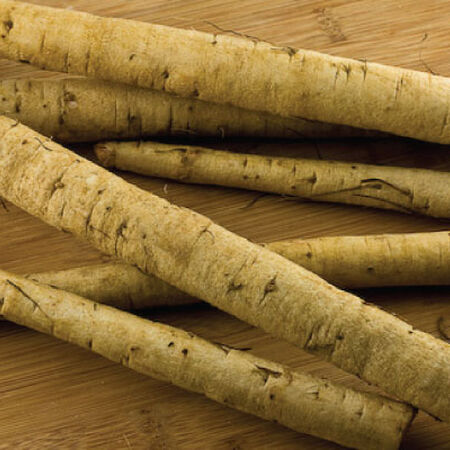Chiko, Burdock Seeds
Key Attributes
Key Attributes
Product Details
Weight
0.006Depth
0.1Height
4.5Width
3.25Plant Height
3-9'Botanical Name
Arctium lappaSeed Type
SeedSeeds Per Gram
77Seeds Per Pound
35,100Row Spacing
24"Packet
50 SeedsSow Depth
3/4"Seeds Per Ounce
2,194Breed
Open-pollinatedSun
Full SunLife Cycle
AnnualSow Method
Direct SowPlant Spacing
2"Categories
BurdockGermination
5,6,7,8,9,10Days To Maturity (# Days)
115Seeds Per Acre
6 lbsComponents
Growing Instructions
![]() Learning Download: How to Grow Burdock
Learning Download: How to Grow Burdock
This is considered an easy plant to grow and has an interesting gamut of uses. The plant can reach up to 9 feet high and produces rough, sticky and burred fruits. It is known to be used for treatment of scalp or skin issues.
Before Planting: Burdock requires a deep, 1-2′, well-drained soil to produce quality roots.
Planting: Sow anytime in spring, about 2″ apart, 3/4″ deep, in rows 24″ apart. Thin to 2-3″ apart. (Average direct seeding rate: 1 oz./230′, 4 1/2 oz./1,000′, 6 lb./acre at 7 seeds/ft. in rows 2′ apart.)
Watering: Water lightly if soil is dry.
Fertilizer: Burdock doesn’t require fertilizer to grow. However, if you notice your plants aren’t growing as quickly as they should or aren’t producing as well, add a balanced fertilizer.
Days to Maturity: Burdock root and leaves can be harvested as early as 8 to 12 weeks after sowing the seeds in the spring.
Harvesting: Burdock leaves should be harvested while they are young and tender. Use a shovel or garden fork and dig a hole next to the root so you can leverage the root into that space.
Tips: If burdock becomes too large, it will quickly become difficult to harvest, which is why it is important to harvest the plant while its young.
Shipping Schedule
Our Seed Promise
 "Agriculture and seeds" provide the basis upon which our lives depend. We must protect this foundation as a safe and genetically stable source for future generations. For the benefit of all farmers, gardeners and consumers who want an alternative, we pledge that we do not knowingly buy or sell genetically engineered seeds or plants.
"Agriculture and seeds" provide the basis upon which our lives depend. We must protect this foundation as a safe and genetically stable source for future generations. For the benefit of all farmers, gardeners and consumers who want an alternative, we pledge that we do not knowingly buy or sell genetically engineered seeds or plants.
The mechanical transfer of genetic material outside of natural reproductive methods and between genera, families or kingdoms, poses great biological risks as well as economic, political, and cultural threats. We feel that genetically engineered varieties have been insufficiently tested prior to public release. More research and testing is necessary to further assess the potential risks of genetically engineered seeds. Further, we wish to support agricultural progress that leads to healthier soils, to genetically diverse agricultural ecosystems, and ultimately to healthy people and communities.
To learn more about the "Safe Seed Pledge" please visit www.councilforresponsiblegenetics.org.

